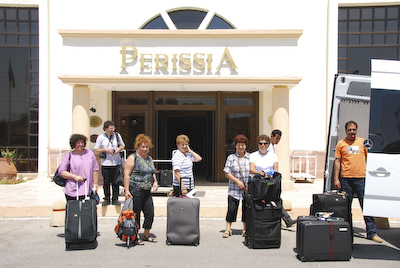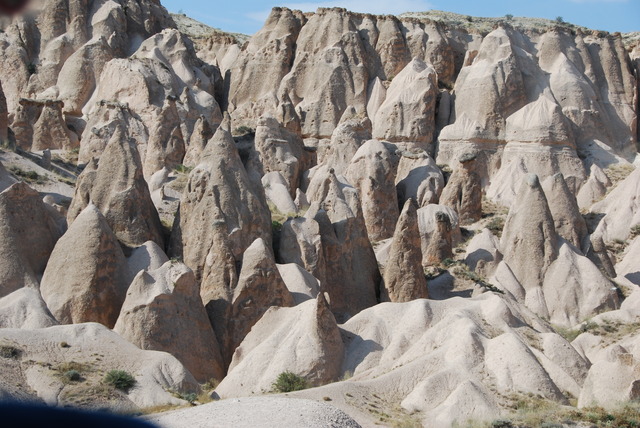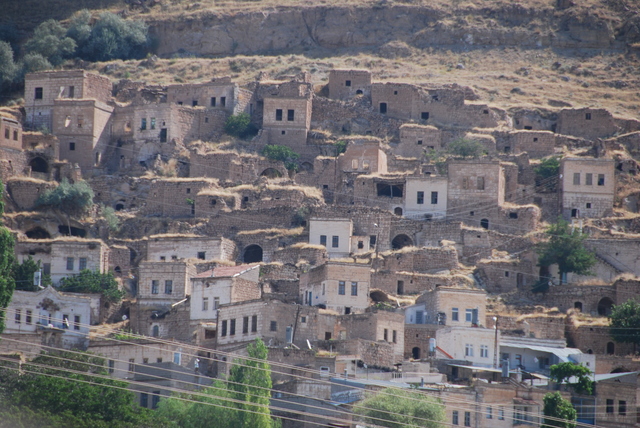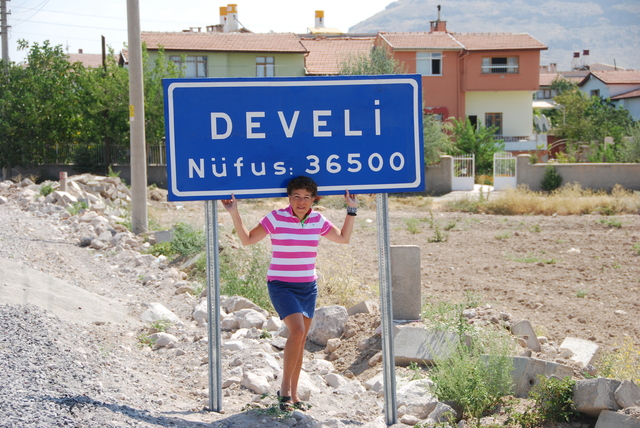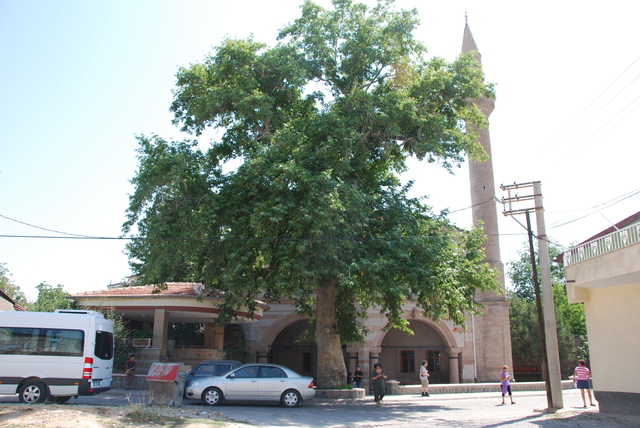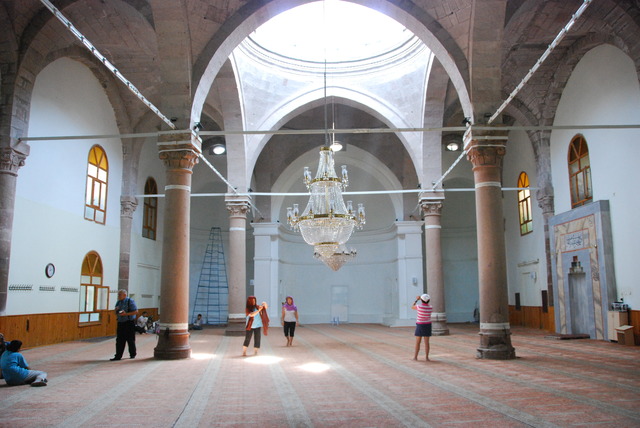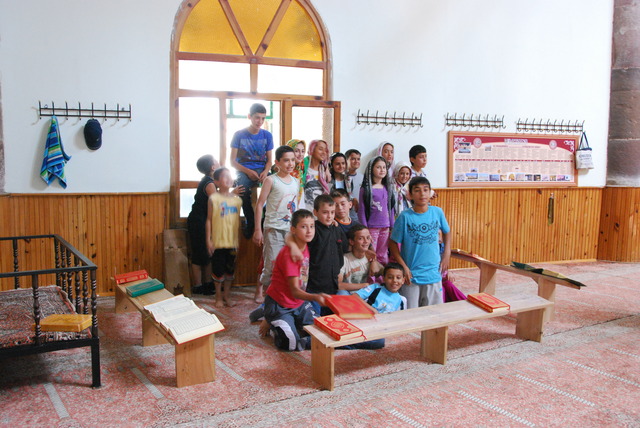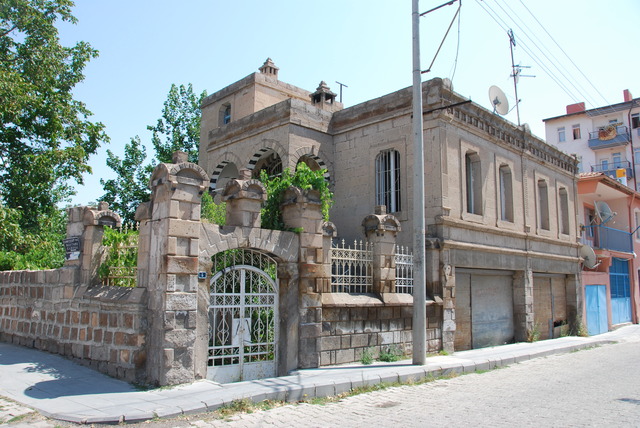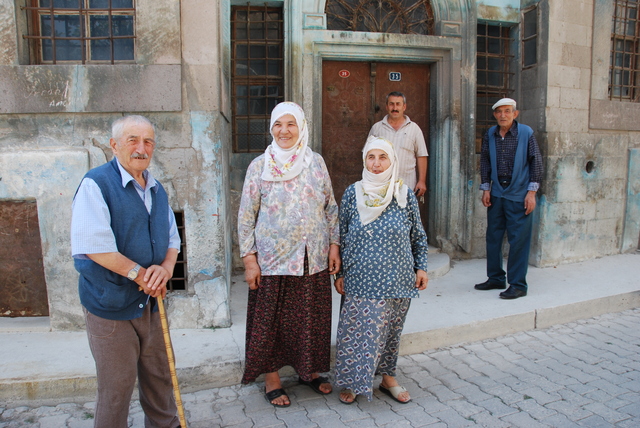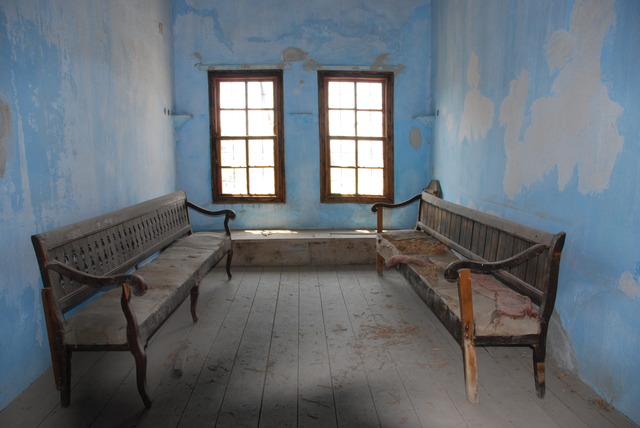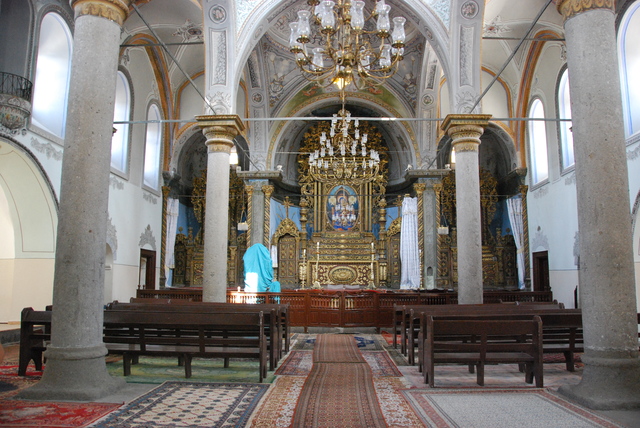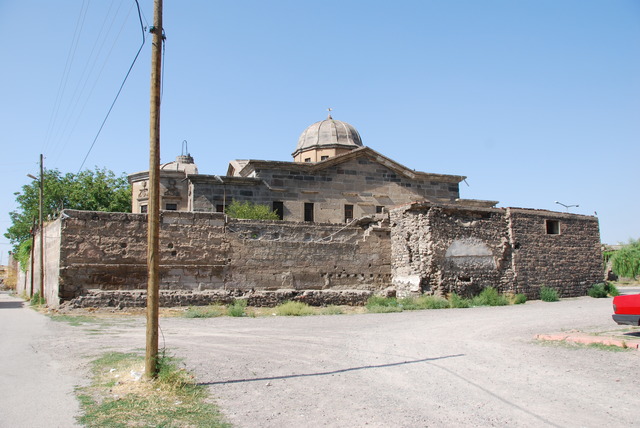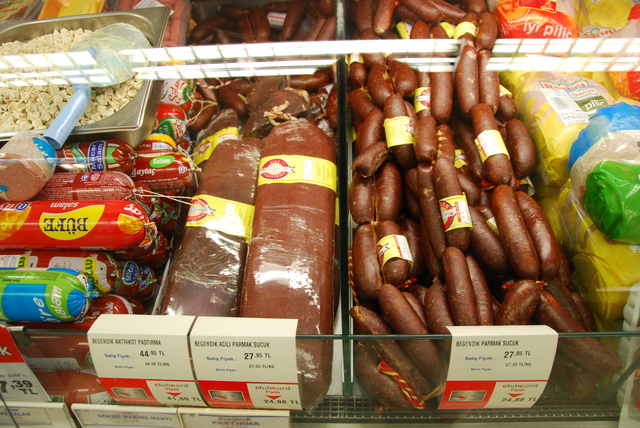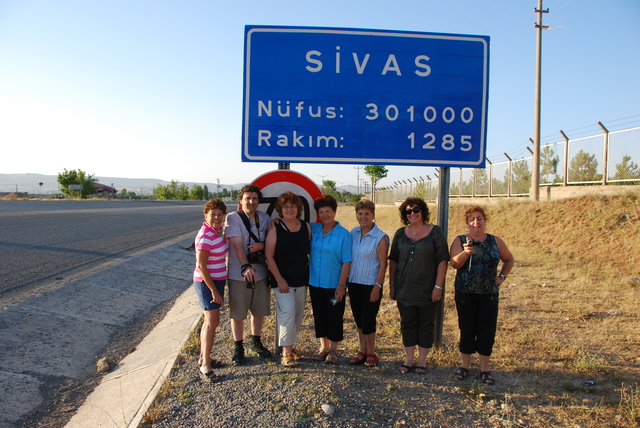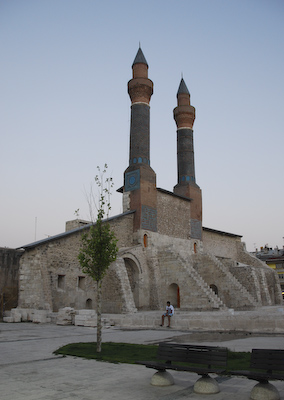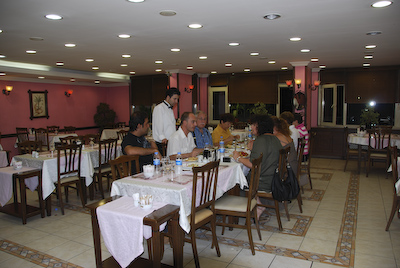The buffet breakfast at the Prissia Hotel was amazing! It had everything you could ever imagine for a hearty breakfast and then some. CeeGee took a morning dip in the lovely pool before breakfast. We ate breakfast together and then packed up and boarded the van to go to Evereg and Fenesse, now called Develi, Turkey.
On the way, we drove past the unusual rock formations of the Cappadocia region, which is known to have one of the most interesting and spectacular landscapes in the world. The van stopped several times to allow us to take photographs. The strange shapes are formed by the effect of erosion on different kinds of rocks.
When Christianity came to the region, chapels, churches and monasteries were constructed into the rocks. There are also a number of historic churches from the Byzantine period. There are also dwellings carved into the rocks and into the sides of the mountains. Many of them have been abandoned or condemned by the government and are not inhabited today.
The Goreme National Park, a UNESCO World Heritage site, was established to preserve some of the cave dwellings, capped pinnacles called: fairy chimneys, rock caves, and other unusual rock formations.
Afterwards, we drove to the city of Develi. It was once composed of four adjoining parts: the Greek quarter of Agiostan, the two Armenian neighborhoods of Evereg and Fenesse, and the Turkish town center of Develi. Today there are very few Armenians left in the Turkish town known as Develi.
My cousin, Roseanne’s maternal grandparents Anoush Donikian and Aghazar Abajian were born in Evereg and Fenesse and survived the genocide of 1915. Aghazar had been a cobbler in Fenesse as a youth. Anoush was baptized in the 200 year old Armenian church of St. Toros. Her father was the parish priest of the church and taught in the adjoining school which Anoush attended.
St. Toros had been converted to a mosque in recent times. However, in 2000, during routine maintenance of the church, the images of the Virgin Mary and a cross appeared on a wall.
We found the Church of St. Toros on a major street in Evereg and Seljuk parked the van. We all got out and went into the mosque to look around. The architecture was that of a traditional Armenian church with the high center dome, but it had a white-washed interior and one minaret had been built outside.
Some children were playing outside and there were two groups of children inside having religious lessons. Our entrance interrupted the Koran classes and the children laughed and waved at us. They followed us around and talked to us in Turkish. They wanted to show us many things and pointed to some Armenian writing on the stones on the exterior of the church.
The children also led the way around the block to their school. This was the school that Roseanne’s grandmother attended and where her great-grandfather taught classes. The Turkish children were adorable. They invited us to their homes and they posed for photos. Then they asked us to post their photos on “Facebook”! :-)
The architecture of Armenian houses is distinctive. They generally have enclosed balconies which are above the sidewalk and are constructed of evenly-cut large stones.
After we said goodbye to the children at the church/mosque, we drove to a house somewhere in the neighborhood which had been owned by an Armenian family whose last name was Bedrosian.
Armen, our guide, knocked on the door of one of the neighbors and asked about the house. The elderly woman who answered the door, said that she had the key and asked if we wanted to go inside. She produced a huge 8 inch key and unlocked the door.
We were overwhelmed by the grandeur of the house. There was a two-story center hall with stone stairs to the second floor. The bedrooms had frescoes painted on the walls and elaborate custom built cabinetry. Although the house had been abandoned and covered with a layer of dirt, it was magnificent.
Roseanne has many good memories of the church and school in her grandparents’ home town. She now knows the original church and school of her grandparents and the kind of life they lived. We also drove into the adjoining part of the city of Develi, known as Fenesse to look for buildings of Armenian architectural style. There were many interesting mosques and black & white patterned buildings, but it was clear that the former Armenian neighborhood had been eliminated.
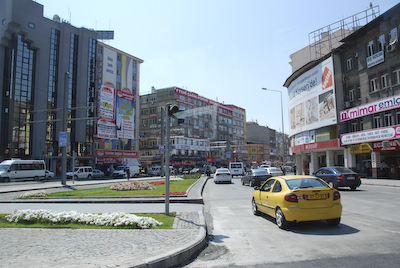 Downtown Kayseri with yellow taxi cabs
Downtown Kayseri with yellow taxi cabs
We left Evereg/Fenesse and drove to the city of Kayseri. The city has great historical significance as an “Armenian Christian Cultural Center”. Kayseri was known as Caesarea in Roman times and was named for Julius Cesar. Mount Erciyes towers in the horizon to the south of the city.
Interior of the Armenian Church in Kayseri
Kayseri was the seat of the Armenian diocese. Saint Gregory the Illuminator, patron saint and first official head of the Armenian Apostolic Church lived and studied in Kayseri. He was the religious leader who is credited with converting Armenia from paganism to Christianity in 301. Armenia became the first country to adopt Christianity as its official religion.
Armenian Church in Kayseri Surrounded by Stone Wall
An Armenian church from the 19th century still operates in the city, although there are only about 15 Armenian families left in Kayseri. We were able to visit this beautiful church and to see how well maintained it is. It is located in the out-skirts of the city in an area of long-abandoned houses and destroyed buildings. The church is in the center of a high stone wall with one thick wood and iron gate for entry.
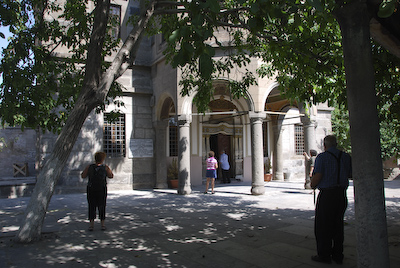 Inner Courtyard and Entrance to the Armenian Church
Inner Courtyard and Entrance to the Armenian Church
A full-time Turkish caretaker and his family live inside the stone compound. We knocked on the heavy door and he let us into the beautiful shady courtyard. Birds were singing and it was a cool and peaceful place. We took walked around, took photos, and talked to a couple of tourists from Great Britain and their German/Turkish guide.
Kayseri is the city which is well known for its production of basturma, a dried beef roll, and sujuk, a spicy sausage. We stopped at a grocery market and purchased both with some bread to nibble on the road to Sivas.
On the way, we stopped at a group of buildings at the side of the road. It was the home of a breeder of the “Kongal” dogs. Cousin Francoise had known about them and asked to see them if possible. We made a quick stop to see these magnificent herding dogs and cute puppies.
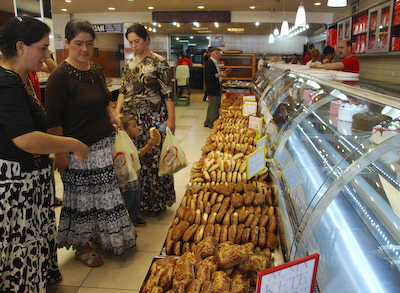 Shopping With Local Women in a Bakery in Kaiseri
Shopping With Local Women in a Bakery in Kaiseri
Then we had a three and a half hour drive to Sivas. The cousins, FRUSAs, laughed and talked and sang and talked and told stories and laughed and talked all the way to the large city of our ancestors. We also enjoyed the Armenian music which was on the CD player in the van.
We are staying at the Sivas Buyuk Hotel, another large modern business hotel. It is clean, modern, and has free WiFi in my room. I just wish it had air conditioning! Sivas is a very large city with lots of traffic and congestion. There are many modern apartment and commercial buildings. Sivas is the capital city of this region of Anatolia.
The journalist, Guilluame Perrier joined us this evening and interviewed our FRUSA Cousins group for his article in Le Monde. That should be fun!
We arrived in Sivas in the late afternoon and we briefly saw the large mosque about a block from the hotel which dates from the 16th century with beautiful blue-tiled minarets.
It is an excellent example of Seljuk architecture at the height of the Ottoman Empire. After we checked into the hotel and received our room assignments, a few of us met downstairs and walked out to see a bit of the city of Sivas and the historic mosque. The sun was setting, but the temperature was still warm.
We met Armen and Guillaume and the other cousins in the lobby of the hotel to talk for a short while before going out to the Lezzetci Gamlik Restaurant for dinner. We ate a delicious dinner of shish-k-bab with rice and green beans. It was a wonderful day!
